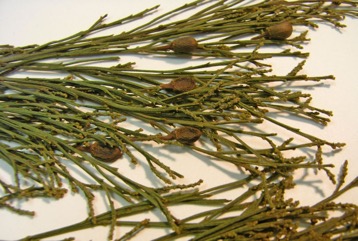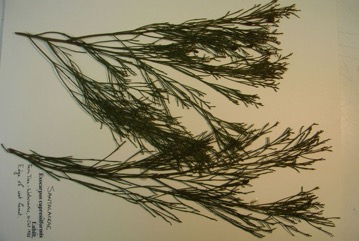Cherry Ballart, Native Cherry, Wild Cherry

It is a warm temperate to subtropical plant. It grows naturally in dry rocky sites near the coast. It is a root parasite and grows as a small understorey tree in dry sclerophyll forests in the drier parts of Tasmania. It can grow in infertile sandy soils. It suits hardiness zones 8-11. Tasmania Herbarium.
Also known as:
Mirrii, Nyora, Palatt, Pul-loitch
Edible Portion
- Fruit, Fruit stalk
Where does Cherry Ballart grow?
Found in: Australia, Tasmania
Notes: There are about 26 Exocarpus species.
Growing Cherry Ballart, Native Cherry, Wild Cherry
Cultivation: It is difficult to propagate because of its parasitic nature. Plants can be cut back and allowed to regrow. The seed need to be sown fresh and possibly with a grass host plant. Plants can also be grown from cuttings. At present such plants tend to be short lived.
Edible Uses: The fleshy fruit stalk is edible. It is eaten raw when ripe. They can also be used to make jam.
Nutrition Info
per 100g edible portion| Edible Part | Energy (kcal) | Protein (g) | Iron (mg) | Vitamin A (ug) | Vitamin c (mg) | Zinc (mg) | % Water |
|---|---|---|---|---|---|---|---|
| - | - | - | - | - | - |
Cherry Ballart, Native Cherry, Wild Cherry Photos


References
Altschul, S.V.R., 1973, Drugs and Foods from Little-known Plants. Notes in Harvard University Herbaria. Harvard Univ. Press. Massachusetts. no. 787
Blomberry, A.M., 1979, Australian Native Plants. Angus and Robertson p 181
Bodkin, F., 1991, Encyclopedia Botanica. Cornstalk publishing, p 467
Boomsma, C.D., 1972, Native Tree of South Australia. Woods & Forests Department South Australia, Bulletin No.19. p 190
Cameron, M., (Ed.) 1981, A Guide to Flowers & Plants of Tasmania. Reed p 82
Caton, J.M. & Hardwick, R. J., 2016, Field Guide to Useful Native Plants from Temperate Australia. Harbour Publishing House. p 346
Cherikoff V. & Isaacs, J., The Bush Food Handbook. How to gather, grow, process and cook Australian Wild Foods. Ti Tree Press, Australia p 10, 195
Clarke, P. A., 2013, The Aboriginal Ethnobotany of the Adelaide Region, South Australia. Transactions of the Royal Society of South Australia. (2013), 137(1): 97-126
Collier, P., 1993, Woodland Wild flowers of Tasmania. Plant Identikit. Society for growing Australian Plants Tasmania Region. Hobart. p 62
Cribb, A.B. & J.W., 1976, Wild Food in Australia, Fontana. p 33
Cronin, L., 1989, The Concise Australian Flora. Reed. p 118
Cundall, P., (ed.), 2004, Gardening Australia: flora: the gardener's bible. ABC Books. p 593
Curtis, W.M., 1993, The Student's Flora of Tasmania. Part 3 St David's Park Publishing, Tasmania, p 627
Dashorst, G.R.M., and Jessop, J.P., 1998, Plants of the Adelaide Plains & Hills. Botanic Gardens of Adelaide and State Herbarium. p 50
De Angelis, D., 2005, Aboriginal Plant Use of the Greater Melbourne Area. La Trobe University Environment Collective
Eddie, C., 2007, Field Guide to Trees and Shrubs of Eastern Queensland Oil and Gas Fields. Santos p 172
Elliot, W.R., & Jones, D.L., 1992, Encyclopedia of Australian Plants suitable for cultivation. Vol 4. Lothian. p 269
Etherington, K., & Imwold, D., (Eds), 2001, Botanica's Trees & Shrubs. The illustrated A-Z of over 8500 trees and shrubs. Random House, Australia. p 319
Gilfedder, L et al, 2003, The Nature of the Midlands. Midlands Bushweb. PO Box 156 Longford, Tasmania. p 103
Gott, B & Conran, J., 1991, Victorian Koorie Plants. PO Box 666 Hamilton, Victoria 3300, Australia. p 31
Hardwick, R.J., 2000, Nature's Larder. A Field Guide to the Native Food Plants of the NSW South Coast. Homosapien Books. p 68
Harris, S., Buchanan, A., Connolly, A., 2001, One Hundred Islands: The Flora of the Outer Furneaux. Tas Govt. p 155
Haslam, S., 2004, Noosa's Native Plants. Noosa Integrated Catchment Assn. Inc. p 181
Hastings Advance Community College, 2017, Uses for Native Plants of the Mornington Peninsula. 86pp. p 43
Hedrick, U.P., 1919, (Ed.), Sturtevant's edible plants of the world. p 304
Heywood, V.H., Brummitt, R.K., Culham, A., and Seberg, O. 2007, Flowering Plant Families of the World. Royal Botanical Gardens, Kew. p 292
Holliday, I., 1989, A Field Guide to Australian Trees. Hamlyn. p 196
Isaacs, J., 1987, Bush Food, Aboriginal Food and Herbal Medicine. Weldons. p 66
Kiple, K.F. & Ornelas, K.C., (eds), 2000, The Cambridge World History of Food. CUP p 1821
Kirkpatrick, J.B. & Backhouse, S., 1985, Native Trees of Tasmania. p 101
Lazarides, M. & Hince, B., 1993, Handbook of Economic Plants of Australia, CSIRO. p 113
Lord, E.E., & Willis, J.H., 1999, Shrubs and Trees for Australian gardens. Lothian. p 15
Low, T., 1991, Wild Food Plants of Australia. Australian Nature FieldGuide, Angus & Robertson. p 136
Low, T., 1992, Bush Tucker. Australia’s Wild Food Harvest. Angus & Robertson. p 46
McKerney, M. & White, H., 2011, Bush Tucker, Boomerangs & Bandages. Border River-Gwyder Catchment Management Authority p 117
Melzer, R. & Plumb, J., 2011, Plants of Capricornia. Belgamba, Rockhampton. p 316
Minchin, R.F., Tasmanian Wildflowers. A Field Guide. Volume one. Regal Publications, Launceston p 82
Morley, B.D., & Toelken, H.R., (Eds), 1983, Flowering Plants in Australia. Rigby. p 233
Plants for a Future database, The Field, Penpol, Lostwithiel, Cornwall, PL22 0NG, UK. http://www.scs.leeds.ac.uk/pfaf/
Ryan, M. (Ed.), 2003, Wild Plants of Greater Brisbane. Queensland Museum. p 170
Smith, K & I., 1999, Grow your own bushfoods. New Holland. Australia. p 28
Low, T., 1992, Bush Tucker. Australia’s Wild Food Harvest. Angus & Robertson. p 1
Nash, D., 2004, Aboriginal Plant Use in south-eastern Australia. Australian National Botanic Gardens. p 4
Tasmanian Herbarium Vascular Plants list p 53
Voy. 1: 156. T. 14. 1799
White, G., 2008, The Bush Tucker Survival Guide. https://www.survival.org.au
Whiting, J. et al, 2004, Tasmania's Natural Flora. Tasmania's Natural Flora Editorial Committee PO Box 194, Ulverstone, Tasmania, Australia 7315 p 308
Williams A. & Sides, T., 2008, Wiradjuri Plant Use in the Murrumbidgee Catchment. Murrumbidgee Catchment Management Authority. Wagga Wagga, p 39
Zola, N., & Gott, B., 1992, Koorie Plants Koorie People. Koorie Heritage Trust. p 47